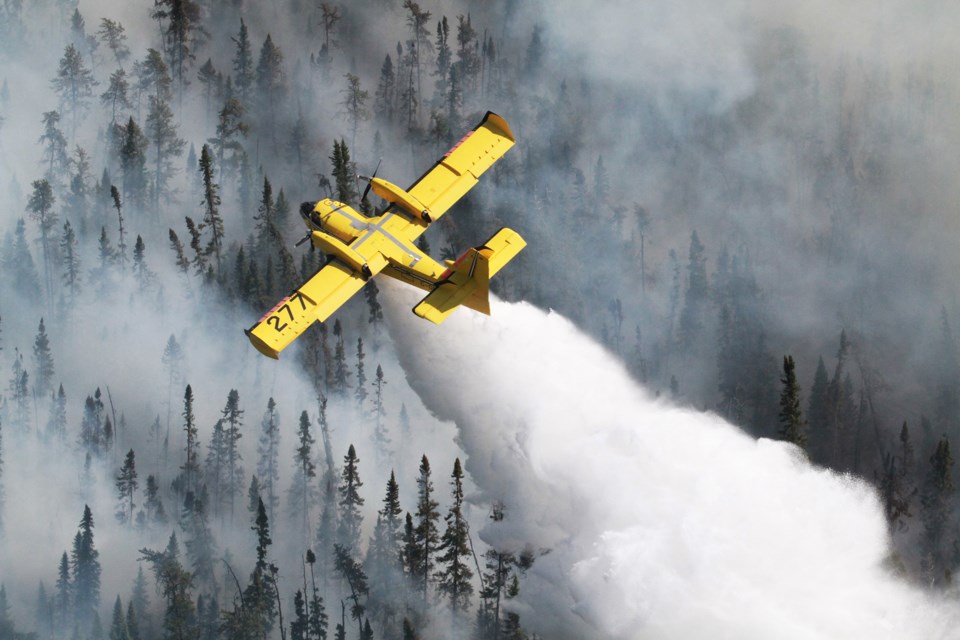War may be hell – as American Civil War General William Tecumseh Sherman is credited with saying – but the people of fire-ravaged California can thank the First World War for lessening the impact of the devastating inferno currently engulfing large portions of their real estate.
Homeowners in “The Golden State” have been singing the praises of the CL-415 waterbombers, nicknamed “Super Scoopers,” that have been sent from Canada to assist in the battle against the heart-breaking wildfires that to date have destroyed more than 12,000 homes, businesses, schools and other structures in the Greater Los Angeles area.
These aircraft, specially built for forest firefighting, are able to scoop up 1,600 gallons of water from nearby lakes or oceans at speeds of up to 160 kilometres an hour (about 100 mph), then dump it on raging firestorms threatening prime forest land or residential areas.
Coincidentally, the Ontario Provincial Air Service (OPAS) – headquartered in this Northern Ontario city just across the border-defining St. Marys River from its sister community in Michigan – celebrated its 100th year of operation in 2024.
Residents of the Soo, as Sault Ste. Marie is known locally, consider the sound of waterbombers literally testing the waters at the start of the season as one of the harbingers of spring after months of brutal winter weather.
Bombing the enemy was a natural extension of the military capabilities of heavier-than-air machines that had been used in battle for the first time in the First World War.
Today, one of the “enemies” of modern life is the forest fire – and it was only a matter of time before attacking this formidable foe from the skies became a valuable tool in the arsenal of the “smoke eaters” charged with extinguishing the conflagrations.
As Royal Canadian Air Force (RCAF) senior historian Major Bill March explained in Canada’s Department of National Defence newsletter, The Maple Leaf, by the
end of 1916 the aircraft had proven itself a key instrument of modern warfare.
“The bloody battles of the Somme (July to November 1916) and Verdun (February to December 1916) demonstrated the utility of airpower for reconnaissance, cooperation with the artillery and infantry, and bombing.”
After the Allied victory, Great Britain and the United States found themselves awash in surplus aircraft. Those they couldn’t sell off they gave away to their partners in “The Great War” who were anxious to kick-start their peacetime economies.
They saw all sorts of uses for these mechanical marvels that had allowed wartime pilots to have “danced the skies on laughter-silvered wings,” as described by RCAF Pilot Officer John Gillespie Magee in his immortal poem “High Flight”.
In 1919, the Canadian province of Québec was being ravaged by costly forest fires, resulting in a group of paper mills testing out the idea of using aircraft to patrol the forests. Up until then, firefighters relied on foot patrols or rudimentary fire towers to spot outbreaks. While outfitting aircraft with firefighting equipment was some years off, there was a great deal of interest in using the machines to locate fires more quickly than contemporary methods were able to do.
Five years later, the Ontario Government set up OPAS as an organization that would operate a fleet of flying boats for the purpose of forest fire patrolling and timber surveying. As the pontoon-equipped aircraft became more sophisticated with the passing years, a natural progression was the invention of waterbombers that evolved into today’s “Super Scooper” CL-415s.
The politician making the decision to create OPAS was James Lyons, the province’s Minister of Lands and Forests. And, like any politician with an eye on re-election, he chose his own provincial riding, which included Sault Ste. Marie, as the headquarters of the operation. This wasn’t exactly a boondoggle though since the Soo is smack dab in the middle of Ontario forest country.
Many of the pilots hired for this fledgling operation were First World War airmen looking to make use of the skills they had learned in the skies over the Western Front during the 1914 to 1918 world conflict. One of those veterans was American-born and Canadian-raised Clarence Alvin “Whispering Duke” Schiller.
The Duke would go on to great adventure in the skies over North America in his relatively short life that ended off the coast of Bermuda during the Second World War as a pilot with the Royal Air Force Ferry Command.
His feats of derring-do over the years included rescuing the crew of the Bremen, the German aircraft that crash-landed off Labrador after making the first successful non-stop crossing of the Atlantic from east to west just months after Charles Lindbergh’s history-making flight in the opposite direction.
Schiller also survived a coma-inducing beating by rumrunners in the Bahamas who had mistaken him for a U.S. prohibition agent. Ironically, just 10 days before, he had saved the life of a Bahamian woman stranded on one of the Out Islands. He flew medical personnel and serum to her in an hour and a half – where the fastest sloop would have taken four days to reach her.
The Duke’s fascinating story – and a thumbnail history of manned flight – can be found here.
A waterbomber from the Sault left this week to potentially fly to California to help fight the fires that have ravaged homes there over the last few weeks.
Tom Douglas, an award-winning journalist and author, has written a number of books about Canada’s military heritage. More information is available here.
